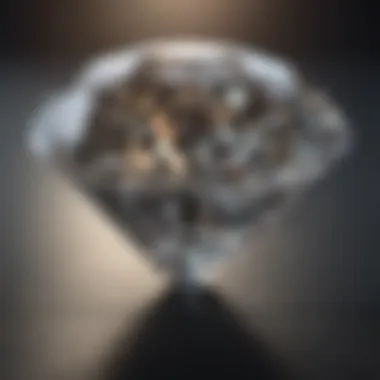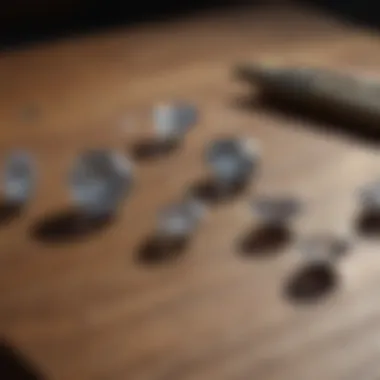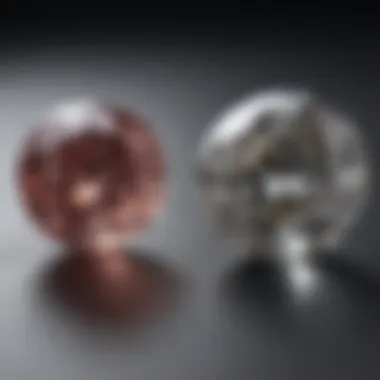Identifying True Diamonds: An In-depth Exploration


Intro
Identifying true diamonds mandates a keen understanding of their intrinsic properties and nuances. These gemstones have captivated humanity for centuries, not only due to their aesthetic appeal but also their rarity and endurance. As a valuable investment or cherished piece of personal jewelry, knowing how to distinguish a genuine diamond from a lab-grown or imitation variant is crucial. With an array of counterfeit materials available, it is prudent to approach diamond assessment with comprehensive knowledge.
In this guide, we delve into the various characteristics of diamonds, their physical traits, and the methods employed for accurate identification. By exploring these aspects, both enthusiasts and collectors will enhance their capability to determine authenticity, whether shopping for a diamond or appraising one.
Gemstone Overview
Description of the gemstone
Diamonds are crystalline forms of carbon, renowned for their stunning clarity and hardness. Their ability to refract light effectively gives them a unique sparkle, making them highly desirable in the jewelry market. Unlike other gemstones, diamonds form under extreme pressure and temperature conditions, typically occurring deep within the Earth’s mantle.
Physical properties
The physical properties of diamonds set them apart from other gemstones. Key characteristics include:
- Hardness: Diamonds rank a perfect 10 on the Mohs scale, indicating unmatched hardness. This property provides durability but also can create challenges when cutting and polishing.
- Refractive Index: The refractive index of diamonds is approximately 2.42, causing light to bend and reflect, contributing to their brilliance.
- Dispersion: Diamonds exhibit remarkable light dispersion with a value of 0.044, leading to the 'fire' effect, displaying a spectrum of colors when illuminated.
- Color: While most diamonds are considered colorless, they exist in a variety of hues, including yellow, blue, and pink. The intensity of color impacts their valuation.
- Clarity: Clarity refers to the presence of inclusions or blemishes within the stone. Higher clarity grades typically indicate higher value.
"A diamond’s unique characteristics demand expert examination to unveil its true identity."
Understanding these physical properties will significantly assist in distinguishing genuine diamonds from alternatives. In the subsequent sections, we will explore testing techniques and expert opinions to provide a holistic approach to identifying true diamonds.
Prolusion to Diamonds
Diamonds hold a unique place in both history and modern culture. Understanding their significance is essential for anyone interested in gemstones. This section covers the importance of diamonds, which extends beyond their physical beauty. The allure of diamonds can be traced back centuries, and their role in various cultures signifies their value. By familiarizing oneself with diamonds, readers are better positioned to appreciate not only their aesthetic qualities but also the deep-rooted traditions surrounding them.
Historical Significance of Diamonds
Diamonds have fascinated humanity for thousands of years. They were first discovered in India around 4,000 years ago and were viewed as symbols of strength and invincibility. Ancient cultures believed that diamonds possessed mystical powers. In many societies, these gemstones were often worn by royalty or used in important religious artifacts.
As trade routes expanded, so did the knowledge about diamonds. They became popular in Europe during the Middle Ages, often associated with status and wealth. The famous diamond mines of South Africa in the 19th century led to an increase in availability, changing how diamonds were perceived and accessed by the general public.
Thus, the historical significance of diamonds is multi-faceted; they are not just gemstones but are linked to power, symbolism, and status across cultures and time.
Types of Diamonds
Diamonds come in various types, each with its specific characteristics and appeal. Understanding the different classifications is crucial for anyone looking to buy or evaluate diamonds.
- Natural Diamonds: These are formed over millions of years through natural processes beneath the Earth's crust. They are the most desirable due to their rarity and natural origin.
- Synthetic Diamonds: Created in laboratories, these diamonds replicate the natural geological processes. While they have similar properties to natural diamonds, they cost significantly less but can sometimes be hard to distinguish.
- Fancy Color Diamonds: These diamonds exhibit colors beyond the typical colorless hue. Their value often depends on the color intensity and rarity.
- Industrial Diamonds: Used mainly for industrial purposes such as cutting and drilling, these diamonds are not suitable for jewelry but are crucial in various manufacturing processes.
Being aware of these different types of diamonds helps buyers make informed decisions. It enables them to choose the right diamond according to their needs, whether for aesthetic value or investment.
Understanding the Properties of Diamonds
Understanding the properties of diamonds is crucial for anyone interested in accurately identifying genuine diamonds. The characteristics that define diamonds not only help in distinguishing them from imitations but also provide insights into their value and desirability. By comprehending these properties, individuals can make informed decisions, whether they are purchasing, appraising, or simply seeking knowledge. In this section, we will delve into key aspects that include hardness, brilliance, fire, color, and clarity.
Hardness and Durability
Diamonds are renowned for their exceptional hardness, rated at 10 on the Mohs scale. This rating signifies that diamonds can only be scratched by other diamonds. This distinguishing feature is essential for buyers and collectors alike. The durability of diamonds makes them an excellent choice for everyday adornment. Considering that many gemstones can be quite soft and susceptible to damage, diamonds stand out in this regard.
Additionally, this hardiness is not just about scratch resistance. The ability of diamonds to withstand pressure and impact contributes to their value. When evaluating a diamond, one should consider its potential to maintain its brilliance through daily wear. This aspect becomes particularly relevant for engagement rings or pieces intended for frequent use. By knowing the hardness and durability of diamonds, you can assess their practicality and longevity as an investment.


Brilliance and Fire
Brilliance refers to the amount of light that reflects off the diamond, while fire indicates the colorful flashes of light produced when a diamond disperses light into its spectral colors. Both attributes are critical in defining a diamond's aesthetic appeal and desirability.
The cut of the diamond plays a central role in its brilliance. A well-cut diamond can maximize light return, creating a captivating sparkle. Cut quality is an essential factor that enthusiasts should consider, as it influences both appearance and value.
"The sparkle of a diamond captivates and enchants; understanding its brilliance is key to true appreciation."
Meanwhile, fire adds an additional layer of beauty, as it creates a kaleidoscope of colors. Observing the interplay of light can provide significant insight into a diamond's quality. When identifying a diamond, assess its brilliance and fire to determine how well the stone captures and reflects light.
Color and Clarity
Color and clarity are two fundamental attributes that significantly impact a diamond's value. Diamonds are typically graded on a color scale ranging from D (colorless) to Z (light yellow or brown). Colorless diamonds are generally more desirable, but each individual's preference may vary. Understanding the nuances of color, including subtle shifts, can enhance your ability to choose a diamond that aligns with personal taste while recognizing its market value.
Clarity measures the presence of internal or external flaws, known as inclusions and blemishes, respectively. A diamond with fewer flaws is often more valuable. Grading is typically done on a scale from Flawless (no inclusions visible under 10x magnification) to Included (flaws visible to the naked eye).
When assessing a diamond, balance between color and clarity is important. Many buyers prioritize one aspect over the other, but understanding both will allow for a well-rounded assessment. By focusing on color and clarity, you can better evaluate a diamond’s overall quality and worth, leading to wiser purchasing decisions.
Common Diamond Imitations
Understanding common diamond imitations is crucial for anyone involved in the gemstone industry or for those purchasing diamonds for personal use. These imitations can vary significantly in composition and physical properties, often leading to confusion among consumers and collectors. By exploring these imitations, one can enhance their ability to discern true diamonds from those that merely mimic their appearance. It is vital not only to recognize these stones but also to understand their implications for value in the market.
Cubic Zirconia
Cubic zirconia, often abbreviated as CZ, is one of the most recognized diamond alternatives available. This synthetic stone is renowned for its clarity and brilliance, making it visually appealing. CZ is manufactured from zirconium dioxide and can be synthesized to exhibit various qualities, such as high refractive index and slight up-take of color.
While cubic zirconia can closely resemble a diamond, there are notable differences. For one, it is softer than diamond, with a hardness rating of about 8 to 8.5 on the Mohs scale. This means that it can be scratched more easily than a genuine diamond, which scores a 10. Additionally, the dispersion of light, referred to as fire, is higher in CZ, giving it more colorful sparkles compared to a natural diamond.
Here are some characteristics of cubic zirconia:
- Generally less expensive than diamonds.
- Available in a broad range of colors.
- Heavier than diamond due to its higher density.
Moissanite
Moissanite is another popular diamond substitute, originally discovered in a meteorite in 1893. Today, it is predominantly created in laboratories, which contribute to its reputation as a conflict-free option. Moissanite possesses impressive optical properties, including a refractive index even higher than that of diamonds. This translates to an extraordinary brilliance and fire that captures light beautifully.
However, distinguishing moissanite from natural diamonds requires some effort. Its unique light performance can create a rainbow effect that is sometimes seen as overly colorful, which can be a giveaway for those who are trained to spot the differences.
Here are key attributes of moissanite:
- Has a hardness of 9.25 on the Mohs scale.
- Less expensive than diamonds, though generally more costly than cubic zirconia.
- Often exhibits a more vivid sparkle than traditional diamonds.
Synthetic Diamonds
Synthetic diamonds, also known as lab-grown diamonds, are produced using advanced technology that replicates the natural conditions under which diamonds form. These diamonds share the same physical, chemical, and optical properties as mined diamonds. They are indistinguishable without specific tools, making them a significant concern for gemologists and jewelers.
The rise in popularity of synthetic diamonds has raised important questions about authenticity and worth. Consumers appreciate the ethical implications, as lab-grown diamonds do not contribute to the negative impacts associated with diamond mining.
Points to consider about synthetic diamonds include:
- They are usually less expensive than their mined counterparts.
- Lack the historical provenance often desired by collectors.
- Are trending as a choice for environmentally-conscious consumers.


With the variety of diamond imitations available, understanding their characteristics becomes essential for accurate identification and valuation of genuine diamonds.
In summary, knowing these common diamond imitations allows buyers to make informed decisions and helps maintain integrity in the jewelry market.
Methods for Identifying Diamonds
Identifying true diamonds is a crucial aspect for gemstone enthusiasts, collectors, and jewelers. The ability to distinguish genuine diamonds from imitations can significantly impact purchasing decisions and valuations. Several methods serve as practical tools for this analysis. These techniques range from simple home tests to more professional evaluations. Understanding these methods can save time, money, and frustration.
The Water Test
The water test is one of the simplest and most accessible ways to distinguish a diamond from other gemstones. This method requires minimal materials, making it ideal for a quick assessment.
To perform the water test:
- Take a glass of water and fill it up.
- Gently drop the stone in question into the glass.
What to observe? A real diamond will sink to the bottom due to its high density. In contrast, many imitations, like cubic zirconia, may float or not sink readily. While this test is not foolproof—it cannot differentiate between diamonds and heavier imitations—it serves well for a preliminary evaluation.
Fog Test
The fog test leverages a diamond's thermal conductivity. Since diamonds disperse heat rapidly, they handle fogging differently than other stones.
To do the fog test:
- Breathe onto the diamond's surface to create fog.
- Observe the fog's behavior.
If the fog dissipates almost instantly, it suggests a true diamond. However, if the fog lingers or takes time to clear, this might indicate an imitation. Although it is a quick method, keep in mind that some real diamonds, particularly those graded lower, might not pass this test.
The Scratch Test
The scratch test, while not recommended for every situation, is a straightforward way to check a stone's hardness. Diamonds rank the highest on the Mohs scale, meaning they can scratch other substances.
To perform the scratch test:
- Attempt to scratch the stone against a glass surface or another material known to be softer than a diamond.
- If scratches appear on the diamond, then it is not genuine.
It must be noted that this test can potentially damage the gemstone, therefore caution is advised. Alternatives include using a hard mineral test kit where you can better preserve the stone's integrity.
Professional Evaluation and Certification
When it comes to verifying the authenticity of a diamond, professional evaluation and certification are crucial steps in the process. These elements go beyond mere visual inspections and subjective opinions. Instead, they provide a systematic approach to ensure that the diamond you own or intend to purchase meets established criteria of quality and authenticity.
By relying on a certified expert, you gain assurance that your diamond has been assessed according to standardized guidelines. This evaluation includes a range of factors such as carat weight, cut, color, and clarity. Understanding these details is significant because each aspect affects the diamond's overall value. Moreover, a certified evaluation takes the guesswork out of identifying true diamonds and allows potential buyers to make informed decisions.
In the realm of gemstones, the benefits of professional certification are manifold. For one, it lends credibility to transactions. When a diamond comes with an official grading report from a reputable gemological institution, buyers can trust that the information is accurate and reliable. This transparency fosters a stronger marketplace, promoting fair practices among sellers and buyers alike.
Additionally, a certified diamond is often considered more valuable than an uncertified one. This increase in value stems from the perceived assurance that comes with a professional endorsement. Collectors and enthusiasts alike are often willing to pay a premium for diamonds that have undergone thorough evaluation and certification.
Lastly, professionals educate clients about the evaluation results. Having a better understanding of your diamond and its certification details enriches your overall appreciation of the gem. This knowledge empowers you in your future purchases or even if you decide to sell.
Importance of Certification


Certification of diamonds is not a mere formality; it’s an essential component of the buying process. Without it, the risk of purchasing an imitation or lower-quality diamond increases significantly. Certification acts as a shield against fraud and deception. A certified diamond generally comes with documentation providing its grading as assessed by experts. This report details the properties of the diamond, and thus serves as a requisite foundation for ensuring that buyers get what they pay for.
Moreover, with various grading systems and opinions on diamonds, certification standardizes evaluations across the industry. Whether the buyer is a novice or a seasoned collector, understanding the certification provides clarity and confidence. Certification documents not only describe the gem's properties but also protect your investment.
Reputable Gemological Institutions
Identifying a genuine diamond often relies on evaluations conducted by trustworthy organizations. The reputation of the gemological institution matters immensely. Institutions such as the Gemological Institute of America (GIA) or the American Gem Society (AGS) are recognized worldwide for their stringent grading systems. Their unbiased and scientifically backed assessments provide the highest degree of trust.
When looking for a certified diamond, ensure that the report comes from one of these reputable sources. It should detail the cut, color, clarity, carat weight, and other essential attributes. You can typically find this information on the institution's website or through the diamond's report number, enabling you to verify the document’s authenticity.
In contrast, lesser-known or unscrutinised grading companies may undermine the value of a diamond certificate. Their evaluations may lack the rigorous methodology adopted by leading institutions, leading to potential discrepancies in diamond assessments. Consequently, it is vital not only to ensure that the diamond is graded but also to confirm that the grading comes from a reliable source. Establishing a connection with a top-tier gemological institution is not just prudent, but intelligent, considering the investment involved.
Cultural Implications of Diamond Ownership
Understanding diamonds transcends their physical attributes. The significance of diamond ownership encompasses cultural, social, and psychological dimensions. Within the framework of this article, the cultural implications suggest how diamonds shape and reflect identity and tradition. They are not merely objects of beauty; they hold substantial value in various cultures.
Diamonds in Different Cultures
Diamonds have been revered across cultures for centuries. In Western society, diamonds often symbolize love and commitment, especially evident in engagement rings. This tradition, popularized in the 20th century, established diamonds as the quintessential choice for romantic gestures. The phrase "A diamond is forever" has embedded itself deeply in Western culture.
In contrast, diamonds are also significant in other global contexts. For example, in India, diamonds are integrated into wedding jewelry, signifying prosperity and protection for the bride. Here, the cultural narrative emphasizes the role of diamonds in auspicious celebrations, marking them as tokens of wealth and stability.
Various tribes in Africa regard diamonds as symbols of power. The physical beauty of these stones parallels the stories and myths attached to them. Some communities also believe in the protective energy that diamonds can provide, leading to their use in rituals and ceremonies.
Symbolism and Status
The ownership of diamonds often conveys status and achievement. In many societies, they function as indicators of wealth and power. Those who own fine diamonds are often seen as part of an elite circle, influencing social dynamics. The rarity of high-quality diamonds contributes to their prestige.
Moreover, the association of diamonds with milestones adds layers of meaning to their ownership. Diamonds are frequently gifted during commemorative occasions, reinforcing bonds within families and communities. Each diamond, thus, tells a story—of love, success, or heritage.
"Diamonds hold a narrative that blends both personal and cultural significance, making them treasures of profound meaning."
In contemporary times, ethical considerations also enter the conversation. The push for conflict-free diamonds reflects changing values in society, emphasizing transparency and moral responsibility. Prospective buyers increasingly wish to align their purchase with their values and those of their community.
In summary, the implications of diamond ownership delve into a multitude of cultural facets—identity, tradition, wealth, and ethics. Understanding these elements enriches the appreciation of diamonds beyond their aesthetic qualities, making the act of identification not just a technical exercise, but a journey through human history and social relations.
Closure and Final Thoughts
Identifying true diamonds is not just a matter of aesthetics but rather an essential skill for anyone involved in the gemstone market. This article emphasizes key techniques and considerations that contribute to an informed understanding of diamond authenticity. As we navigate through various tests and evaluations, the practical knowledge gained empowers buyers and collectors alike. Being able to distinguish a genuine diamond from an imitation can prevent significant monetary loss and emotional disappointment.
The importance of recognizing real diamonds extends beyond personal purchase decisions. Cultural implications and social status associated with diamond ownership shape consumer perceptions and market dynamics. Having clarity on how to identify these gems can enhance one’s appreciation for their beauty and significance.
Moreover, as competition among sellers increases, knowing how to discern quality becomes a critical survival skill in the market. Without this knowledge, buyers may rely solely on assertions made by sales personnel, leading to potential misrepresentations.
Summarizing Key Points
- Understanding Diamond Properties: Learn the unique characteristics that define true diamonds, including hardness, brilliance, and fire.
- Testing Techniques: Familiarize oneself with basic tests such as the water test, fog test, and scratch test.
- Professional Insight: The role of gemological institutions and certification in verifying diamond authenticity.
- Cultural Context: Recognize how diamonds are perceived in various cultures and their symbolism.
With these frameworks, readers are equipped to navigate the complexities of diamond identification confidently.
Encouragement for Further Learning
The world of diamonds and gemstones is vast and evolving. As new technologies emerge, techniques transition and expand for identifying diamonds and their imitations. Staying updated with current trends and advancements in gemology is critical. Engaging in continuous learning can significantly enhance your competence and reliability as a gemstone enthusiast or professional.
Reading academic journals, attending gem shows, and participating in workshops can broaden one's understanding. Online communities, such as those found on platforms like Reddit, Facebook, or dedicated gemology forums, also offer insight and opportunities for discussion. By exploring these resources, individuals can share experiences and knowledge, further enriching their expertise in diamond identification.
Interested readers are encouraged to access reputable sources like Wikipedia and Britannica for deeper insights into specific areas of diamond studies.







